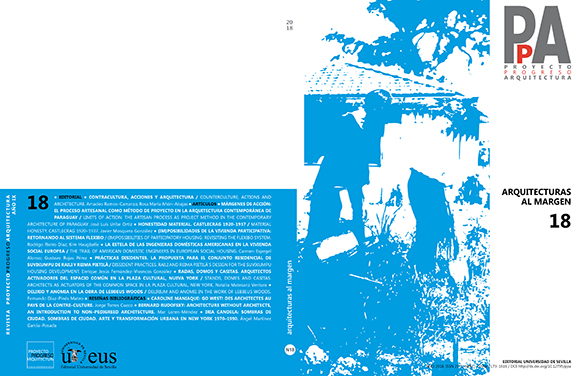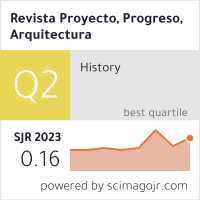LA ESTELA DE LAS INGENIERAS DOMÉSTICAS AMERICANAS EN LA VIVIENDA SOCIAL EUROPEA / THE TRAIL OF AMERICAN DOMESTIC ENGINEERS IN EUROPEAN SOCIAL HOUSING
DOI:
https://doi.org/10.12795/ppa.2018.i18.04Parole chiave:
vivienda colectiva, domesticidad, racionalización, mecanización, cocina, ingenieras domésticas / collective housing, domesticity, rationalization, mechanization, kitchen, domestic engineersAbstract
RESUMEN El presente artículo analiza la gran influencia que los Manuales escritos por las norteamericanas Catharine Beecher, Christine Frederick y Lillian Gilbreth tuvieron sobre la concepción de la domesticidad en los programas residenciales de la Nueva Oficina de Construcción de Frankfurt, liderada por Ernst May entre 1925 y 1930, en la que Margarete Schütte-Lihotzky se encargó del estudio de los hábitos de vida.
Desde posiciones muy diversas, como la intelectualidad de Beecher, el pragmatismo de Frederick y el cientifismo de Gilbreth, todas ellas tipificaron, hicieron eficiente y optimizaron, respectivamente, la concepción proyectual y productiva de la vivienda. Esto implicaba racionalizar, modernizar y mecanizar su contenido con el fin de mejorar el trabajo del ama de casa. En sus textos, no se cuestiona si el lugar apropiado para la mujer es el hogar, sino que se afirma que no está bien ideado. Por primera vez, la casa es pensada desde un nuevo punto de vista: el del usuario.
A través del artículo se revelan, desde un punto de vista no planteado anteriormente, algunos de los posibles medios de transmisión de las investigaciones americanas al contexto europeo.
SUMMARY This article analyzes the great influence that the Manuals written by Catharine Beecher, Christine Frederick and Lillian Gilbreth had in the conception of domesticity in the residential programs carried out by the New Frankfurt initiative led by Ernst May between 1925 and 1930, in which Margarete Schütte-Lihotzky was in charge of studying life habits.
From their different stances, Beecher’s intellectualism, Frederick’s pragmatism and Gilberth’s scientism, they all typified, made more efficient and optimized, respectively, the design and productive conception of the house. This meant rationalizing, modernizing and mechanizing its content with the aim of improving the work conditions of the housewife. Their texts do not question whether the home is the adequate place for women, they just state that its spaces are not correctly thought out. For the very first time, the house was conceived from a new perspective: that of the user.
This article reveals, from a novel point of view, some of the possible means by which the research carried out by these American women reached the European context.
Downloads
Riferimenti bibliografici
BAUDRILLARD, Jean. Le système des objets. Paris: Éditions Gallimard, 1968.
BEECHER, Catharine. A Treatise on Domestic Economy, for the Use of Young Ladies at Home and at the School. Boston: Marsh, Capen, Lyon y Webb, 1841.
BEECHER, Catharine, BEECHER STOWE Harriet. The American Woman’s Home or Principles of Domestic Science Being a Guide to the Formation and Maintenance of Economical Healthful Beautiful and Christian Homes. New York: J. B. Ford and Co., y Boston: H. A. Brown & Co., 1869.
BEHNE, Adolf. Der moderne Zweckbau. Vienna/Berlin: Drei Masken Verlag, 1923. Traducido al español 1923. La construcción funcional moderna. Barcelona: Ed. del Serbal, 1994.
BERNÈGE, Paulette. Vers une cuisine automatique. En: Mon Chez Moi. Fascículo IV, 1 de Octubre 1923 – 1 de Noviembre 1923, pp. 25-29.
BOOT, Marjan y CASCIATO, Maristella (ed.). La casalinga riflessiva. La cucina razionale come mito domestico negli anni ’20 e ’30. Catálogo de Exposición, Octubre-Noviembre 1983, Palazzo delle Esposizioni. Roma: Multigrafica Editrice, 1983.
ECO, Umberto. El vértigo de las listas. Barcelona: Ed. Lumen, 2009.
ECO, Umberto. Apocalípticos e Integrados. Barcelona: Ed. Lumen, 1965.
ELSAESSER, Thomas. The Camera in Kitchen. Grete Schütte-Lihotzky and Domestic Modernity. En Christiane SCHÖNFELD, ed. en colaboración con Carmel FINNAN, Practicing Modernity: Female Creativity in the Weimar Republic. Würzburg: Königshausen & Neumann, 2006, pp. 27-49.
Ernst May und das neue Frankfurt 1925-1930, Catálogo de la Exposición en el Deutschen Architekturmuseum, Frankfurt am Main. Berlin: Wilhelm, Ernst & Sohn, 1986.
Ernst May: DAS NEUE FRANKFURT: Fünf Jahre Wohnungsbau in Frankfurt am Main. Frankfurt: Henrich Editionen, 2011.
FREDERICK, Christine. The New Housekeeping: Efficiency Studies in Home Management. Garden City (New York): Doubleday, Page & Company, 1913.
FREDERICK, Christine. Household Engineering: Scientific Management in the Home. Chicago: American School of Home Economics, 1920.
FREDERICK, Christine. Le Taylorisme chez soi. Pratique de la direction de la maison. Paris: Dunod Editeur, 1920.
FREDERICK, Christine. Die rationelle Haushaltführung. Betriebswissenschaftliche Studien. Berlin: Julius Springer Verlag, 1921.
FREDERICK, Christine. Naukowa organizacja w gospodarstwie domowen. Warsaw: Nakladem Instytuta Naukowej Organizacji, 1926.
FREDERICK, Christine. De Denkende Huisvrouw. Haarlem: Tjeenk Willink, 1928.
FREDERICK, Christine y TEALDY, Lorenzo. La donna e la casa. Il taylorismo della vita domestica. Torino: C. Accame, 1928.
FREDERICK, Christine. Selling Mrs. Consumer. New York: The Business Bourse, 1929.
GIEDION, Sigfried. Mechanization Takes Command: A contribution to Anonymous History. New York: Oxford University Press, 1948.
GILBRETH, Lillian. The Psychology of Management: The Function of the Mind in Determining, Teaching and Installing Methods of Least Waste. New York: Sturgis & Walton Company, 1914.
GILBRETH, Frank B. y GILBRETH, Lillian. Fatigue Study: The Elimination of Humanity’s Greatest Unnecessary Waste. A First Step in Motion Study. New York: Sturgis & Walton Company, 1916.
GILBRETH, Frank B. y GILBRETH, Lillian. Ermüdungsstudium (Fatigue Study). Eine Einführung in das Gebiet des Bewegungsstudiums. Berlín: Verlag des Vereines Deutscher Ingenieure, 1921.
GILBRETH, Lillian. Verwaltungspsychologie. Berlin: Verlag des Vereins dt. Ingenieure, 1922.
GINZBURG, Moisei. Stil’i epokha, Moskva: Gosizdat, 1924. Traducido al inglés por Anatole Senkevitch, Jr. Style and Epoch. Cambridge (Massachusetts): MIT Press, 1982.
GROPIUS, Walter. Die Kunst In Industrie Und Handel. Jena: Verlag Eugen Diederichs, 1913.
HAYDEN, Dolores. The Grand Domestic Revolution: A History of Feminist Designs for American Homes, Neighborhoods, and Cities. Cambridge (Massachusetts): MIT Press, 1981.
LE CORBUSIER-SAUGNIER. Vers une architecture. Paris: Les Editions G. Cres et Cie., 1923. Traducido al español Hacia una arquitectura. Barcelona: Ediciones Apóstrofe, 1977.
MCLEOD, Mary. “Architecture or Revolution: Taylorism, Technocracy, and Social Change”. Art Journal, vol. 43, n.º 2, pp.132-147.
MENDELSOHN, Erich. Amerika: Bilderbuch eines Architekten, Berlin: Rudolf Mosse Buchverlag, 1926. Versión inglesa: Erich Mendelsohn’s “Amerika”: 82 Photographs, New York: Dover Publications Inc., 1993.
MEYER, Erna. Der neue Haushalt ein Wegweiser zu wirtschaftlicher Haushaltsführung. Stuttgart: Franckh’sche Verlagshandlung, 1926.
NOEVER, Peter (ed.). Margarete Schütte-Lihotzky. Soziale Architektur Zeitzeugin eines Jahrhunderts, Wien: Bóhlau, 1993.
SCHÜTTE-LIHOTZKY, Margarete. Rationalisierung im Haushalt. En: Das Neue Frankfurt, n.5, 1926-1927, pp.120-130. Traducido al inglés en KAES, Anton; JAY, Martin and DIMENDBERG, Edward. The Weimar Republic Sourcebook. Grete Lihotzky. Rationalization in the Household. Berkeley: University of California Press, 1994.
TAUT, Bruno. Die Neue Wohnung. Die Frau als Schöpferin. Leipzig: Klinkhardt & Biermann, 1924.
##submission.downloads##
Pubblicato
Come citare
Fascicolo
Sezione
Licenza
Las ediciones impresa y electrónica de esta Revista son editadas por el Secretariado de Publicaciones de la Universidad de Sevilla, siendo necesario citar la procedencia en cualquier reproducción parcial o total.
Salvo indicación contraria, todos los contenidos de la edición electrónica se distribuyen bajo una licencia de uso y distribución “Creative Commons Atribución-NoComercial-SinDerivar 4.0 Internacional” ![]() . Puede consultar desde aquí la versión informativa y el texto legal de la licencia. Esta circunstancia ha de hacerse constar expresamente de esta forma cuando sea necesario.
. Puede consultar desde aquí la versión informativa y el texto legal de la licencia. Esta circunstancia ha de hacerse constar expresamente de esta forma cuando sea necesario.
Los autores/as que publiquen en esta revista aceptan las siguientes condiciones:
- Los autores/as conservan los derechos de autor y ceden a la revista el derecho de la primera publicación, con el trabajo registrado con la licencia de atribución de Creative Commons, que permite a terceros utilizar lo publicado siempre que mencionen la autoría del trabajo y a la primera publicación en esta revista.
- Los autores/as pueden realizar otros acuerdos contractuales independientes y adicionales para la distribución no exclusiva de la versión del artículo publicado en esta revista (p. ej., incluirlo en un repositorio institucional o publicarlo en un libro) siempre que indiquen claramente que el trabajo se publicó por primera vez en esta revista.
- Se permite y recomienda a los autores/as a publicar su trabajo en Internet (por ejemplo en páginas institucionales o personales) antes y durante el proceso de revisión y publicación, ya que puede conducir a intercambios productivos y a una mayor y más rápida difusión del trabajo publicado (vea The Effect of Open Access).









